Table of Contents
🥣 What Is Moroccan Lentil Stew?
There’s something magical about the first spoonful of warm, gently spiced Moroccan Lentil Stew. The aroma alone, infused with cumin, turmeric, and slow-simmered tomatoes, wraps around you like a wool blanket on a cold day. In Morocco, this dish is more than just comfort food; it’s a daily ritual, a mother’s go-to recipe, and sometimes the first thing a child learns to cook.
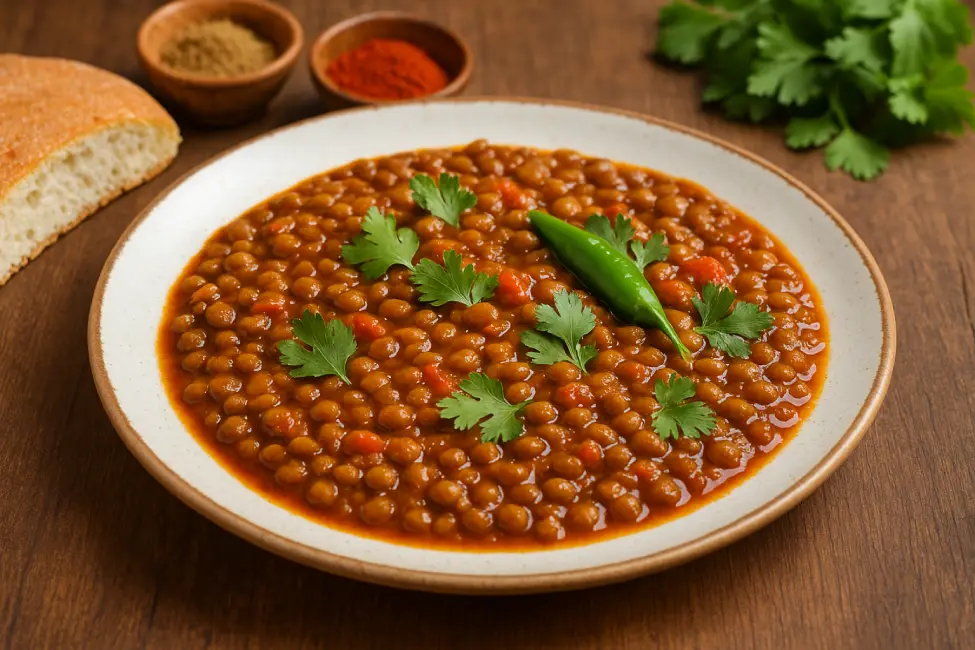
Growing up in a small town near Fès, my neighbor Amina prepared lentils almost every Monday. I still remember walking past her open kitchen window on winter afternoons. The scent of sautéed garlic and olive oil would fill the air, and you’d know, before even seeing the pot, that a hearty Moroccan Lentil Stew was on the stove. She always cooked a big batch, served it steaming hot in deep bowls, and insisted that bread, not a spoon, was the best utensil.
🍲 A One-Pot Wonder with Centuries of Tradition
Moroccan Lentil Stew, locally called “3dess”, is a thick, savory mixture of brown or green lentils simmered in a blend of Mediterranean vegetables and North African spices. Its dense texture and rich flavor, achieved without meat or cream, set it apart from ordinary lentil soup. It’s naturally vegan, gluten-free, and incredibly nourishing.
Unlike many Western stews that rely on stock cubes or animal fats for flavor, Moroccan cooking celebrates the natural taste of ingredients, elevated by a careful combination of:
- Ground cumin
- Sweet paprika
- Turmeric
- Fresh garlic and tomatoes
- Chopped parsley or cilantro
Even with simple ingredients, this stew delivers warmth, boldness, and a taste that lingers like a good memory.
🌍 A Global Dish Rooted in Home
Today, Moroccan Lentil Stew is finding its way into modern kitchens far beyond North Africa, and for good reason. It offers everything a thoughtful home cook looks for today: ease of preparation, rich natural flavors, and nourishing ingredients that align with a healthy, balanced lifestyle.
- ✅ One-pot simplicity
- ✅ Affordable pantry staples
- ✅ Packed with fiber and plant protein
- ✅ Perfect for meal prep or batch cooking
Whether you embrace a plant-based diet, explore Mediterranean cuisine, or simply search for a comforting dinner, this stew fits into every lifestyle. It’s also a brilliant alternative to heavier stews, especially for healthy weeknight dinners without sacrificing flavor.
If you’re curious about other beloved Moroccan comfort dishes, don’t miss our detailed guide on how to make the perfect Harira soup, another warm and wholesome staple that tells its own delicious story.
🧠 Did You Know?
Lentils are among the oldest cultivated legumes in the world, traced back over 8,000 years, and are essential in Mediterranean diets. Healthline says they’re an excellent source of plant-based protein, iron, and soluble fiber, making them ideal for heart health and blood sugar control.
❤️ In Every Bowl: A Story of Generosity
In Moroccan culture, food is love. Large clay pots of lentil stew are often placed in the center of the table, with family and guests gathered around, each tearing pieces of warm bread to scoop generous portions. Sharing from a single pot is symbolic, it speaks of trust, connection, and tradition passed down from generation to generation.
So the next time you prepare Moroccan Lentil Stew, remember: you’re not just cooking lentils, creating a moment of warmth, rooted in centuries of culture.
🌿 Ingredients and Traditional Spice Blend
🧅 Core Ingredients for Authentic Flavor
At the heart of any delicious Moroccan Lentil Stew lies a handful of humble, pantry-friendly ingredients that, when cooked with care, deliver an intensely flavorful and wholesome dish.
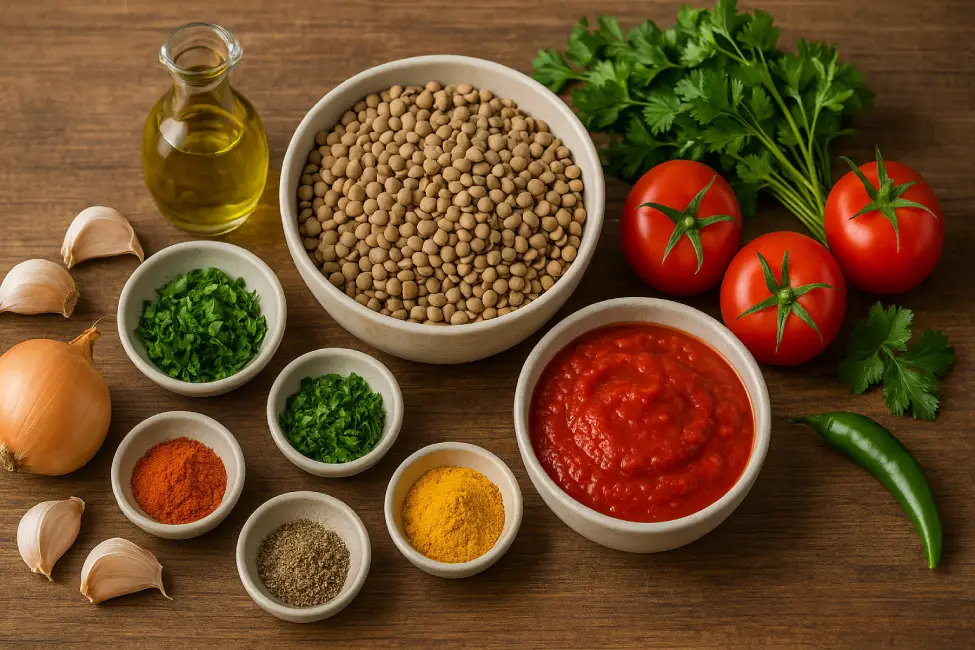
Here’s what you’ll need to make it just like in a Moroccan home kitchen:
- 400g brown lentils, soaked in water for a few hours or overnight
- 60ml olive oil, to form a rich base
- 3 garlic cloves, crushed
- 200g grated onions, for depth and sweetness
- 2 tbsp tomato paste
- 400g tomato purée, or fresh blended tomatoes
- 1.3L water, to simmer the lentils
This recipe builds flavor from scratch, thanks to the natural richness of slow-cooked vegetables and spices, unlike soups that rely on broth cubes. Soaking the lentils is more than a cooking trick; it’s a traditional technique that shortens the cooking time and improves digestion.
Pro tip: In Moroccan kitchens, lentils are often soaked in the morning while preparing lunch, so they are ready by dinner. It’s all about rhythm and planning, defining home cooking across generations.
For more authentic Moroccan recipes that warm the soul, explore our Moroccan Bastilla chicken: A Crispy & Flavorful Delight and start your culinary journey today.
🧂 The Signature Moroccan Spice Mix
Spices are the soul of Moroccan cooking. In this Moroccan lentil stew, the warm, earthy blend transforms basic lentils into a comforting and intensely aromatic dish.
You’ll need:
- 2 tsp cumin
- 2 tsp paprika
- 1 tsp turmeric
- 1 tsp ground ginger
- ½ tsp black pepper
- ¼ tsp chili powder (optional)
In some regions, this spice mix is called “chermoula khadra.” It is green without preserved lemon or saffron and is typically used in legumes and fish-based dishes.
What makes Moroccan spices special isn’t just their presence and balance. No one flavor dominates; instead, they dance in harmony. The Spruce Eats explains Moroccan spice blends with helpful insights if you want to learn more about how spices are used in Moroccan cuisine.
And remember: you can always skip the chili powder if you prefer a milder taste.
🥕 Optional Add-ins: Carrots, Potatoes, and More
While the classic version keeps it simple, Moroccan home cooks often customize the stew based on what’s available. Here are a few popular add-ins that blend beautifully with lentils:
- Diced carrots – for sweetness and color
- Cubed potatoes – to make it more filling
- Chopped celery stalks – for extra depth
- Bay leaves add a gentle layer of aroma between floral and herbal, enhancing the stew’s slow-cooked depth.
- Sliced green chili – added on top during the final minutes for a spicy kick
In the video recipe, the cook adds a whole green chili at the end and lets it steam inside the pot, a small yet impactful touch that enhances aroma without overpowering the dish.
🌿 Fresh Herbs: Parsley vs. Cilantro in Moroccan Cooking
No Moroccan lentil stew is complete without herbs, and here’s where every family has its preference: parsley, cilantro, or both.
In this recipe:
- 1½ tbsp finely chopped parsley
- 1½ tbsp finely chopped cilantro
In my grandmother’s kitchen, parsley was for body, cilantro for spirit. Together, they created a finish that felt rooted and vibrant. They created a wonderfully layered aroma that finished the dish with freshness.
In Moroccan homes, the choice often depends on the region. In the north, cilantro is favored. In the south, parsley rules. But most cooks, like the one in our video, use both equally for balance, beauty, and authenticity.
🍲 How to Make Moroccan Lentil Stew, Step-by-Step
Regarding cozy, home-cooked meals, nothing beats the simplicity and comfort of a well-made Moroccan Lentil Stew. Whether you prefer to simmer it on the stove or use a modern Instant Pot to save time, the result is a hearty, one-pot vegetarian dish filled with rich, spiced flavors. Let’s walk through the whole preparation process, step by step, with a helpful video to guide you visually.
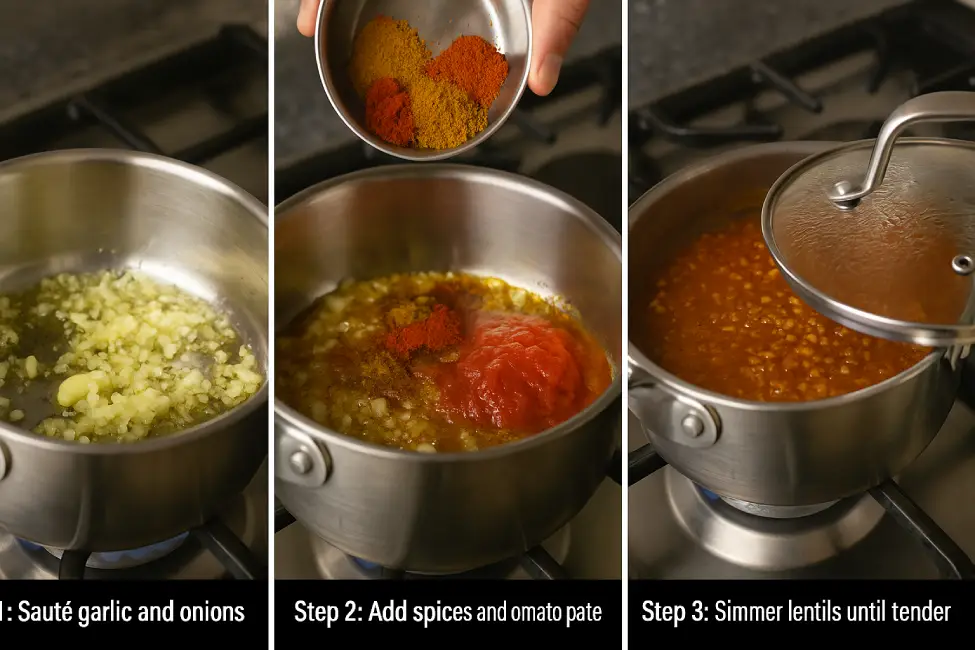
🍳 Cooking in a Traditional Pot (Slow Simmer Method)
This is the classic way lentils are prepared in Moroccan kitchens. It allows the ingredients to meld gently and build deep flavor, all in a single pot.
Steps to follow:
- Start by soaking 400 grams of brown lentils in 1 liter of water for several hours or overnight. This step helps them cook faster and more evenly.
- Warm 60 ml of olive oil in a large pot over medium heat.
- Add 3 crushed garlic cloves and gently cook until their aroma is released and they turn golden.
- Toss in 200 grams of grated onion and stir well, allowing it to soften for a few minutes.
- Sprinkle in your spice blend: cumin, paprika, turmeric, ground ginger, black pepper, and chili powder if you like some heat.
- Mix in 2 tablespoons of tomato paste and 400 grams of tomato purée, stirring until well incorporated.
- Add finely chopped parsley and cilantro, about 1½ tablespoons each, to freshen and balance the flavors.
- Pour in 1.3 liters of water, then add the soaked and drained lentils.
After mixing everything, allow the stew to simmer slowly and steadily. Then reduce the heat, cover, and let it simmer for 45 to 50 minutes, stirring occasionally to avoid sticking. During the final 10 minutes, you can lay a whole green chili on top and let it steam, this adds a subtle spice and a fragrant touch without overwhelming the dish.
If you love hearty, slow-cooked meals, you might also enjoy our traditional Rfissa with lentils and chicken, another staple full of warmth and flavor.
⚡ Quick Version: Instant Pot or Pressure Cooker
Pressed for time? This stew adapts wonderfully to pressure cooking while retaining all its authentic taste.
If you’re opting for a pressure cooker or Instant Pot, here’s how to proceed:
- No soaking needed, just rinse the lentils well.
- Use the sauté function to heat the olive oil, garlic, and onions until soft and fragrant.
- Incorporate the tomato concentrate, blended tomatoes, aromatic herbs, and ground spices into the mix.
- Add the rinsed lentils with 1.3 liters of water, and mix well to combine.
For cooking time:
- In an Instant Pot, set the temperature to high for 15 minutes, then allow natural release.
- In a stovetop pressure cooker, cook for 15 minutes once it begins to whistle, then let it cool on its own.
Once the pressure has naturally released, carefully remove the lid and assess the consistency of the stew. If it’s too thick, add warm water and simmer for 5 more minutes with the lid off.
According to Serious Eats, pressure cooking is one of the best ways to retain lentils’ nutrients while dramatically reducing cooking time. pressure cooking is one of the best ways to retain lentils’ nutrients while dramatically reducing cooking time.
🎯 How to Get the Perfect Stew Texture
What sets this stew apart is its ideal consistency, thick and hearty yet never dry or mushy. It should be soft enough to scoop with bread but still hold its form on a spoon.
✅ Texture tips:
- Stir occasionally to prevent the lentils from sticking and burning at the bottom.
- Use gentle simmering rather than high heat to help lentils soften evenly.
- If the stew becomes too thick, add warm water gradually and mix.
- For extra creaminess, press some of the lentils against the side of the pot during the last 10 minutes of cooking.
Avoid using flour or other thickeners, the lentils naturally create a velvety finish as they break down slightly.
❌ Mistakes to Avoid (Overcooking, Overseasoning)
Even simple recipes can go sideways if rushed. Here’s what to keep in mind:
- Cooking too long at high heat can cause lentils to break down too much and become pasty.
- Underseasoning or adding too many spices early may mask the lentils’ natural flavor. It’s better to adjust salt and spice near the end.
- Skipping the soaking step (using traditional methods) requires extra simmering time, don’t forget to check for doneness.
- Not tasting before serving is a common mistake. A quick final adjustment of salt, heat, or acidity can elevate the dish from good to great.
🍽️ Serving Suggestions & Variations
Moroccan Lentil Stew is a rare, comforting, and flexible dish. Its humble base makes it easy to transform into various meals, whether you’re craving something light, spicy, hearty, or regional. Let’s explore some of the most delicious and authentic ways to enjoy it.
🫓 Best Sides to Enjoy with Moroccan Lentil Stew (Including Bread, Rice & Eggs)
In Morocco, lentil stew is almost always enjoyed with khobz, a round, crusty, homemade bread perfect for scooping up every bit of the sauce. Using a spoon is optional when there’s good bread on the table.
Other great sides include:
- Steamed rice – a soft, neutral base that absorbs the rich tomato and spice sauce
- Sliced hard-boiled eggs are often placed on the side, offering a simple way to boost the meal’s protein content.
- Marinated olives – mainly black or cracked green olives for contrast
- A crisp tomato and cucumber salad adds a refreshing contrast that cuts through the richness of the stew.
When serving guests or family dinners, a traditional spread might include spicy harissa, olives, and small mezze-style plates, much like what you’d see with our Moroccan Couscous, where simplicity meets balance.
🥣 Turn It Into a Lentil Soup or a Dip
One of the best things about this plant-based stew is how easily you can adjust its texture.
➡️ For a soup:
After cooking, add ½ to 1 extra cup of hot water or vegetable broth and gently simmer for 5 minutes. The result is a warming bowl of comforting vegan food, ideal for chilly evenings or light lunches.
➡️ For a dip or spread:
Allow the mixture to thicken further on low heat, then gently press some of the lentils to create a smooth, velvety base. Serve with pita triangles or vegetable sticks. Whether served warm or chilled, it is a flavorful and filling starter.

You can even blend some of the stew for a creamy texture without adding dairy, an excellent idea for mezze platters or sandwich fillings.
🌶️ Make It Spicy or Mild: Adapting the Heat Level
Heat in Moroccan cuisine is not always dominant, but this stew allows room for personal preferences.
Here’s how to tailor the spice:
- For a mild version, simply omit chili powder and don’t add any fresh chili.
- For moderate heat, simmer with a whole green chili during the last 10 minutes (as shown in the video).
- Add ½ teaspoons of harissa paste, red pepper flakes, or a finely chopped red chili during cooking for spicy lovers.
Always taste before serving, spices like cumin and paprika deepen over time, and balancing heat with acidity (like a squeeze of lemon) brings everything together.
If you’re curious about bold Moroccan flavors with a spicy edge, try our Chicken Tagine with Prunes and Cinnamon. This dish beautifully balances sweet and heat.
🌍 Variations Around the Mediterranean (Lebanese, Algerian Twists)
Although this recipe is uniquely Moroccan, similar lentil-based dishes exist across the Mediterranean and North Africa, with subtle regional differences.
✅ Lebanese-style lentils (mujadara) often include caramelized onions served over rice.
✅ Algerian versions may feature chickpeas or harissa-based sauces for extra heat.
✅ Tunisian adaptations might add preserved lemon or serve the stew alongside grilled seafood.
You can make your version by:
- Red lentils instead create a softer, silkier consistency that melts into the stew.
- Adding chickpeas or diced carrots for variety
- Adding a preserved lemon or fresh zest gives the stew a vibrant, citrusy lift that enhances its depth.
For more insight into Mediterranean lentil recipes and their cultural variations, Epicurious offers an excellent guide to adapting lentils to various cuisines.
This stew’s adaptability makes it so beloved, from traditional Moroccan households to modern plant-based kitchens worldwide. Serve it your way, and don’t hesitate to make it your own.
❤️ Health Benefits & Why You’ll Love It
Beyond its bold flavors and comforting texture, Moroccan Lentil Stew is also a powerhouse of nutrition. It embodies everything you could want in a wholesome dish: filling, healthy, easy to prepare, and incredibly cost-effective. Whether cooking for one or feeding a big family, this recipe checks all the right boxes for your taste buds and well-being.
💪 Packed with Protein, Iron & Fiber
Lentils are often praised as one of the most nutrient-dense legumes, for good reason. They’re a fantastic source of plant-based protein, making this stew a perfect choice for vegetarians, vegans, or anyone cutting back on meat.
In just one serving, you’ll get:
- A generous amount of protein to support muscle health
- Plenty of iron, essential for plant-based diets
- A rich dose of soluble and insoluble fiber, which helps digestion and keeps you full longer
Pairing lentils with ingredients like tomatoes, onions, and olive oil enhances flavor and supports the absorption of nutrients like iron. According to Harvard T.H. Chan School of Public Health, lentils help lower cholesterol, stabilize blood sugar levels, and support heart health.
🧘 Vegan, Gluten-Free & Family-Friendly
This dish is a win for just about every dietary preference. Naturally vegan and gluten-free, it fits seamlessly into various lifestyles without requiring substitutes or special ingredients.
Plus, the flavor profile is mild and flexible, making it easy to adapt for kids or spice lovers alike. Want it smoother for a toddler? Mash it lightly. Want it spicier? Add chili or harissa to your portion only.
It’s a great way to introduce your family to the rich world of Mediterranean and North African flavors without straying from familiar comfort food territory.
If you want to develop more family-friendly recipes with Moroccan soul, our Zesty Moroccan Meatballs are a perfect follow-up, packed with flavor yet simple enough for everyday meals.
🧊 Perfect for Meal Prep & Freezing
A few dishes, such as Moroccan Lentil Stew, also work for meal prep. This stew keeps well refrigerated, and its flavors often deepen and improve after a day or two.
Meal prep benefits:
- Stays fresh in the fridge for up to 5 days
- Freezes well for 2–3 months in airtight containers
- It warms up easily, whether reheated on the stovetop or microwave.
- Can be used as a soup, dip, or wrap filling later in the week
Because it’s a one-pot meal, cleanup is minimal, and you can easily double the batch for future lunches or dinner emergencies.
💸 A Budget-Friendly Dish That Feeds a Crowd
In times when grocery bills are rising, a healthy lentil dish that’s also economical is more valuable than ever. Lentils are one of the most affordable sources of nutrition available worldwide, and the supporting ingredients, onion, garlic, tomato, spices, are pantry staples.
One large pot of this stew can generously feed a family of four, often with leftovers. Served with bread or rice, it becomes a filling meal that costs just a few cents per serving.
It’s no wonder that dishes like this have become essential in Moroccan households for generations, nourishing, satisfying, and practical. And now, you can bring that same tradition to your kitchen.
Explore our Authentic Moroccan Bissara, a minimalist fava bean soup rich in fiber, flavor, and history, for more traditional, budget-conscious Moroccan meals.
✨ Whether you’re cooking for your health, your family, or your wallet, Moroccan Lentil Stew delivers. More than just a meal, this stew provides nourishment, warmth, and a deep connection to cultural heritage with every bite.
❓ Frequently Asked Questions about Moroccan Lentil Stew
1. What type of lentils should I use for Moroccan Lentil Stew?
Brown or green lentils are recommended for an authentic flavor and texture. They hold their shape well during slow cooking, giving the stew a hearty bite. Red lentils can also be used for a creamier texture, but they cook faster and tend to break down more.
2. Do I need to soak lentils before cooking Moroccan Lentil Stew?
Allowing lentils to soak for several hours or overnight shortens how long they need to cook and makes them easier on the stomach. However, it’s not mandatory. If you skip soaking, expect to cook the lentils a bit longer and check for doneness regularly.
3. Is Moroccan Lentil Stew suitable for vegan and gluten-free diets?
Absolutely! This stew is naturally vegan and gluten-free, made from simple plant-based ingredients like lentils, tomatoes, and spices, perfect for those with dietary restrictions or preferences.
4. How spicy is Moroccan Lentil Stew? Can I adjust the heat?
The stew can be mild or spicy, depending on your taste. Traditional recipes often include a whole green chili simmered gently for a subtle heat. You can skip chili powder for a milder version or add harissa or chopped chilies for more spice.
5. What should I serve with Moroccan Lentil Stew?
It pairs beautifully with Moroccan bread (khubz), rice, or hard-boiled eggs. Fresh salads and olives also perfectly complement the rich, spiced flavors.
6. Can I prepare Moroccan Lentil Stew in a pressure cooker or Instant Pot?
Yes, this stew adapts well to pressure cooking, significantly reducing cooking time while preserving nutrients and flavor. Follow the recipe steps for best results.
7. How long does Moroccan Lentil Stew keep in the fridge?
Stored in an airtight container, it stays fresh for up to five days. The stew’s taste intensifies as it rests, making the next day’s portions more delicious.
8. Can I freeze Moroccan Lentil Stew?
Definitely! Freeze portions in airtight containers for up to 2–3 months. Remove frozen servings to thaw in the fridge overnight, then gently reheat on the stove or in the microwave.
🔚 Conclusion
Moroccan Lentil Stew is more than just a meal, it celebrates simple ingredients transformed by rich spices, tradition, and care. Whether new to Moroccan cuisine or a seasoned home cook, this one-pot vegetarian dish offers comfort, nutrition, and incredible versatility.
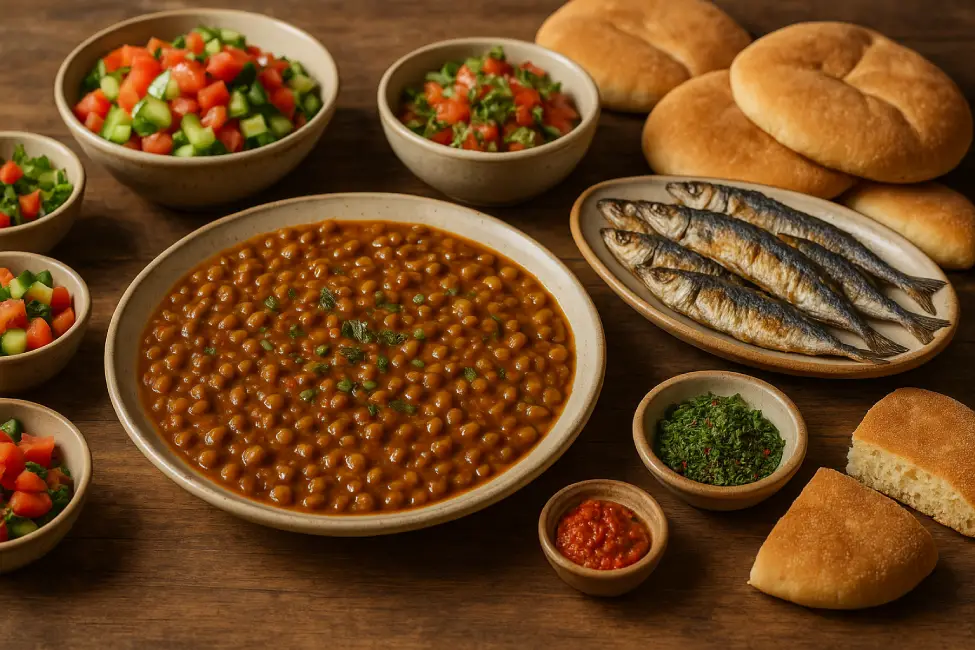
By embracing this recipe, you’re nourishing your body with protein, fiber, and essential nutrients and welcoming a piece of Moroccan culture into your kitchen. Its ease of preparation, budget-friendly nature, and adaptability make it a perfect addition to any weeknight dinner rotation.
Ready to bring these vibrant flavors to your table? Grab your ingredients, follow the steps, and don’t hesitate to experiment with your favorite spices or sides. We’d love to hear how your Moroccan Lentil Stew turns out, share your experience and tips in the comments below!
Explore our complete collection and start your culinary journey today for more authentic Moroccan recipes that warm the soul.
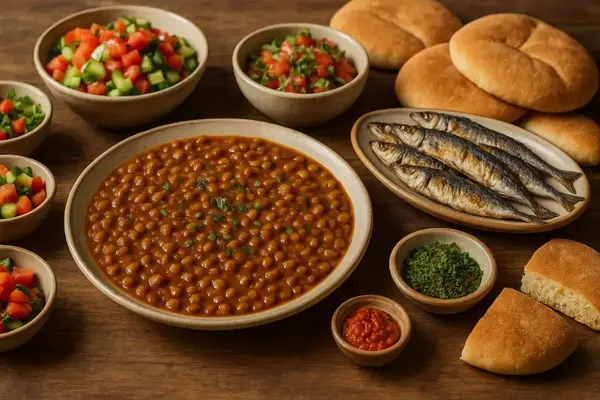
How to Make Moroccan Lentil Stew in Just One Pot
Ingredients
📝 Ingredients List :
- 400 g brown lentils soaked for a few hours or overnight
- 60 ml olive oil
- 3 garlic cloves crushed
- 200 g grated onions
- 2 tsp salt
- 2 tsp ground cumin
- 2 tsp paprika
- 1 tsp turmeric
- 1 tsp ground ginger
- ½ tsp black pepper
- ¼ tsp chili powder optional
- 2 tbsp tomato paste
- 400 g tomato purée
- 1½ tbsp finely chopped parsley
- 1½ tbsp finely chopped cilantro
- 1.3 L water
- 1 green chili optional, for steaming on top
Instructions
👨🍳 Instructions :
- Prepare the lentils: Soak lentils in 1L of water for at least 3 hours or overnight. Drain before use.
- Sauté aromatics: In a large pot, heat olive oil over medium heat. Add garlic and onions, and cook until soft and golden.
- Spice it up: Add cumin, paprika, turmeric, ginger, black pepper, and chili powder. Stir well.
- Add tomato base: Mix in tomato paste and purée. Let it cook for 2–3 minutes.
- Add herbs: Stir in chopped parsley and cilantro.
- Combine & cook: Pour in water and add soaked lentils. Bring to a boil.
- Simmer: Cover and simmer on medium-low for 45–50 minutes, stirring occasionally.
- Finish: During the last 10 minutes, place a green chili on top (optional). Adjust seasoning before serving.
Notes
- For a spicier version, add harissa or more chili powder.
- Serve with Moroccan khobz, rice, or fresh salad.
- Can be blended slightly for a soupier texture or mashed partially to use as a dip.
🍽️ Moroccan Lentil Stew, Nutrition Facts (Per Serving)
| Nutrient | Amount (Approx.) |
|---|---|
| Calories | 320 kcal |
| Protein | 17 g |
| Carbohydrates | 42 g |
| Dietary Fiber | 15 g |
| Sugars | 7 g |
| Total Fat | 10 g |
| Saturated Fat | 1.5 g |
| Sodium | 720 mg |
| Iron | 5 mg (28% DV) |
| Vitamin A | 18% DV |
| Vitamin C | 22% DV |
| Calcium | 6% DV |
| Potassium |
Note : Values are approximate and may vary depending on specific ingredients and portion sizes.
📲 Stay Connected with Us!
Loved this Moroccan Lentil Stew or planning to try it soon? 🥄
Join our community of Moroccan food lovers on social media! Follow us for more authentic recipes, cooking tips, and behind-the-scenes content straight from the kitchen.
👉 Tag your creations with #TajineRecipes and share your twist on traditional Moroccan dishes.
Let’s cook, connect, and celebrate Moroccan flavors together!
🔗 Follow us on :
#MoroccanLentilStew #MoroccanFood #TajineRecipes #OnePotMeals #HealthyMoroccan #MoroccanKitchen #PlantBasedRecipes #MoroccanCooking #ComfortFood #LentilStew
✉️ Don’t Miss a Bite, Join Our Newsletter!
Hungry for more delicious Moroccan dishes like this Moroccan Lentil Stew? 🍲
Subscribe to our newsletter and be the first to discover new recipes, traditional cooking secrets, and smart kitchen tips, delivered straight to your inbox every week.
It’s free, easy, and crafted with love for real food lovers 💚
No spam, just flavor!
👉 Enter your email to join the TajineRecipes family today!
📩 Join Our Moroccan Foodie Community
Get the best Moroccan tagine recipes and seasonal culinary tips straight to your inbox.
💬 What Did You Think?
Tried this Moroccan Lentil Stew at home? We’d love to hear from you!
Tell us how it turned out, what variations you made, or if it brought back any memories of Moroccan flavors.
Your feedback helps other readers and inspires us to keep sharing more authentic, delicious recipes.
👇 Leave a comment below and let’s start a flavorful conversation!
